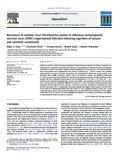Resistance of rainbow trout Oncorhynchus mykiss to infectious hematopoietic necrosis virus (IHNV) experimental infection following ingestion of natural and synthetic carotenoids
Share
抄録
Further to previous studies showing modulation of innate immune responses by dietary carotenoids, an experiment was conducted to examine the resistance to a viral pathogen in rainbow trout after oral ingestion of synthetic or natural carotenoids. Rainbow trout fry weighing 0.11 g on average (n = 30) were fed casein-based semi-purified diets supplemented with 100 mg carotenoids kg− 1 diet for 6 weeks. The synthetic sources tested were pure β-carotene, astaxanthin, and canthaxanthin, whereas the natural sources were Dunaliella salina, Phaffia rhodozyma, Tagetes erecta, and Capsicum annuum. No significant differences (P > 0.05) in growth and feed performance were found among the groups after 6 weeks of feeding. Subsequently, fish were challenged by immersion in two concentrations (2 × 103 and 2 × 104 TCID50 ml− 1) of a virulent strain of infectious hematopoietic necrosis virus (IHNV) and cumulative mortalities were recorded over a 30-day period. No significant differences in survival (P > 0.05) were found among the groups when challenged with the high viral dose. However, at the lower viral dose, mortality was markedly reduced in fish fed astaxanthin (22%). Consequently, this group exhibited the highest relative percent survival (RPS) of 58%, which was significantly different from the control (P < 0.05). Rainbow trout fed D. salina and T. erecta among the natural sources, had reduced mortality rates and elevated RPS that, nonetheless, did not significantly differ from the control. This study highlights the influence of carotenoids, particularly astaxanthin, in maintaining fish health and disease resistance.
Suggested Citation
Amar, E. C., Akutsu, T., Satoh, S., & Watanabe, T. (2012). Resistance of rainbow trout Oncorhynchus mykiss to infectious hematopoietic necrosis virus (IHNV) experimental infection following ingestion of natural and synthetic carotenoids. Aquaculture , 330-333, 148-155. https://doi.org/10.1016/j.aquaculture.2011.12.007
Collections
- AQD Journal Articles [1249]

